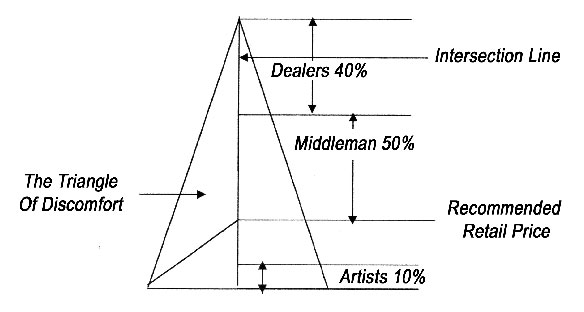This is continued from a series I just began to document my back-logged “read but don’t remember that well” and “to read” lists, inspired by online groups like Printmaking Professors Network, Printmakers Open Forum, and the infamous Tabs-my-husband-Blake-leaves-open-on-our-computer. You can see all of the posts in this series, here: https://www.orangebarrelindustries.com/category/blog-2/readings/
There is just SO much collected knowledge on these Facebook Groups/Pages. For example, looking back through the archives (I’ve decided to approach them like reading a book and taking notes), I found the answer to a question I’ve been tentatively texting friends about and was honestly a bit shy to ask on the Group/Pages.


Maybe once I’m well into this massive endeavor, I’ll reorganize these based on categories into new posts.
More from Printmaking Professors Network Facebook Group
I wasn’t doing this from the start (sorry, I often dive into things then partway through realize there is a better organizational system), but I’m going to provide the person’s name who shared this suggestion in ( ) or before the entry when I’m quoting their description of the reading suggestion.

From Regarding Australian Aboriginal Art, Richard Bell’s Bell Theorem
- Joe Biel Of Microcosm Publishing Using Neurodiversity As His Superpower, https://the-art-of-autism.com/joe-biel-of-microcosm-publishing-using-neurodiversity-as-his-superpower/?fbclid=IwAR2r1BMn4fSP0pjSrYgDiDRT1vYKprZfBSyuVFAGbv8KKODbh0r-YWQtOws (Katie Ries)
- History of Editioning, https://tecnicasdegrabado.es/2009/numeracion-de-estampas?fbclid=IwAR1pvDTns9UuxZaD_VpWBuwbBkLRyKp3Zn2e9Wj06rHjjiv4p-ZNMOFz8TM (Shelley Thortensen)
- Kathryn Reeves’ comment on the history of editioning prints, “Limited editions seem to have started with commercial publishers in England, based on economic theory of supply and demand (scarcity creates more demand). In the late 19th century, a prominent member of Royal Society of Painter-Etchers (now called Royal Society of Painter-Printmakers) decried limited editions and the practice of cancelling plates while still in good conditions as barbarism.”
- Reuben Castillo on the history of editioning prints, “Look up Hieronymus Cock and In der Vien Winden (“House of the Four Winds”). It was one of the most important first major print publishing businesses.”
- Jeffery Dell on the history of signing/editioning prints, https://thefineartsociety.com/usr/documents/exhibitions/list_of_works_url/14/whistler-prints-catalogue-2016.pdf?fbclid=IwAR3FgSMYM1XRN10S7Edbs9UuhlHG_U8rB-ojzNoCupibpRHLgQMGasMYNZ4
- Alcide Nikopol on the history of singing/editioning prints, “It was not common to number and sign impressions before sometime after 1850. Whistler and Halden are commonly credited with having established this, after Whistler’s relocation to London. (11 „The presence of the artist’s signature suggests the artist’s immediate involvement. But since Whister, who charged double for for individually signed impressions of his prints, the print trade has capitalized on the artist’s signature to increase the value of the product.”
The Image Multiplied, Susan Lambert, Trefoil Publications, London 1988, pg 33) “(Quote and corresponding footnote from [her] thesis on collaborative printing)” - Phyllis McGibbon on the history of signing/editioning prints, “I remember June Wayne talking about her push to standardize editioning/signing at Tamarind (although she initially thought that the practice would protect artists, she had misgivings later on when she noticed how signed, unsold editioned prints impacted estate taxes following an artist’s death). I wonder, does anyone have a copy of Silvie Turner’s “About Prints” book, done in the mid 1990’s for Camberwell College of art? It might go into the history of editioning and perhaps reinforce some of the info shared on this thread- I seem to remember her doing research on signing practices for print artists.”
- “How Prints Look” by William M. Ivins, Jr. (Bill Ritchie)
- Perspectives on Contemporary Printmaking: Critical Writing Since 1986, edited by Ruth Pelzer-Montada, Manchester University Press, 2018. (Kathryn Reeves)
- Devin Abbott Mihesuah, So You Want to Write About American Indians? A Guide for Students, Writers and Scholars. (RuthAnn Godelli)
- Regarding Australian Aboriginal art, Richard Bell’s Bell Theorem – http://www.kooriweb.org/foley/great/art/bell.html (Ben Rak)
“During the last century and a quarter Western Art has evolved into an elaborate, sophisticated and complex system. This system supplies venues (museums, galleries, etc), teaching facilities (art education institutions, drawing classes, etc) and referees (art critics) and offers huge rewards for the chosen few elite players in the game (including artists, curators, art critics, art dealers and even patrons). This arrangement is not dissimilar to modern spectator sports. It is also not unlike ancient religions – substitute Gods, sacrificial offerings, High Priests, etc.
Like some voracious ancient God, Western Art devours all offerings at will. Sometimes the digestion will be slow and painful. However, it is resilient and will inexorably continue on its pre-ordained path that is to analyse and pigeonhole everything.
Western Art is the product of Western Europeans and their colonial offspring. It imposes and perpetuates superiority over art produced in other parts of the World. For example, the African Masks copied by Picasso. Westerners drooled at Picasso’s originality – to copy the African artists while simultaneously ignoring the genius of the Africans.
Any new ‘art movement’ is, after the requisite hoopla and hype, named and given an ISM, that is duly attached to the end of a noun, e.g.. ‘Modernism’. This ‘nounism’ doesn’t transfer to non-Western art. Words like primitive, ethnographic, provincialist or folk-art suffice. Below the ISMs are “Schools”. A noun followed by School. For example, the Heidelberg School.
Aboriginal Art is considered a ‘movement’ and as yet has not graduated to ISM status by being named. I shall do so now. I name Aboriginal Art HIEROWISM. It is the modern hieroglyphics. Also, there is always controversy (lotsa rows) so I think it’s appropriate. So. How is it that an unqualified Black can’t name an Art Movement?”
- Art Critiques: A Guide by James Elkins (Amze Emmons)
- What Happened to Art Criticism by James Elkins (Tate Foley)
- Phyllis McGibbon on Readings for Criticism, “RISD recently put out a book called “The critical art of making” which contains a very thoughtful essay, “Groundwork” by Leslie Hirst, who teaches in their foundations program. While it’s not about crit techniques per say, I think it really encourages students ( particularly art students in a liberal arts setting) to reflect more thoughtfully on what’s happening in a studio course, and how the framework of an assignment and dialogue about it supports a different kind of thinking.”
- Beth Grabowski on Readings for Criticism, “I like Terry Barrett’s discussion of Criticism in his book Criticizing Photographs – I’ve had students assume his critical stances of “skeptic’ and “advocate” to discuss each other’s work – it was a good. McEvilley’s essay ” On the Manner of Addressing Clouds (especially the sub-section,13 ways of looking at a Blackbird) is a classic. He discusses the ways meaning is constructed. Another good resource is Kendall Buster and Paula Crawford’s The Critique Handbook, which gives some strategies on various ways to approach a critique. Re: the Elkins texts… He makes some interesting points, but I find the book to be rather cynical and have stopped using it. I don’t entirely believe in/experience what he says, perhaps that reflects the fact that I don’t teach at an Art school.” (Also recommended by Stephanie Hunder)
- Anita Jung on Readings for Criticism, “Liz Lerman is a dancer and choreographer. She has developed a critique style entitled, Critical Response Process. There are lots of PDFs and stuff online. It basically does what one would like to discover through the critique process and teaches individuals how to critique. My students really liked it and adapted strategies taken from it, which then taught them to be active facilitators of their critiques as well as the importance of having a listener take notes for them.”
- Ruth Pelzer-Montada (ed.) ‘Perspectives on contemporary printmaking: Critical writing since 1986’. Manchester: Manchester University Press, 2018. ISBN: 9781526125750 (Kathryn Reeves)
- Ruth Pelzer-Montada (ed.) ‘Perspectives on contemporary printmaking: Critical writing since 1986’. Manchester: Manchester University Press, 2018. ISBN: 9781526125750. Book will be available in Spring/Summer 2018. (Kathryn Reeves)
- Kathryn Reeves states, “For undergrads, a good intro to theory and criticism is Laurie Schneider Adams, ‘The Methodologies of Art: An Introduction’ 2nd ed. The methodologies she discusses are ‘formal analysis, iconology and iconography, Marxism, feminism, biography and autobiography, psychoanalysis, structuralism, race and gender–reflect the multiplicity of meanings in an artistic image. The second edition includes nineteen new images, new sections on race, gender, orientalism and colonialism, along with a new epilogue that approaches a single painting– Titian’s Rape of Lucrezia — to illustrate the different methodological viewpoints.'”
- Practices in looking (Amze Emmons)
- White Cube by Brian O’Doherty (Leslie Friedman)
- October Magazine from MIT Press, Available on JSTOR (Leslie Friedman)
- The Revolution: Women Who Transformed Contemporary Art (Leslie Friedman)
- The Reckoning: Women Artists of the New Millennium (Leslie Friedman)

Mika Rottenberg, Still from Cheese, 2007. Courtesy Nicole Klagsbrun Gallery, New York, and Andrea Rosen Gallery, New York.
- Dropbox Organized by Beauvais Lyons along with participants from an SGCi inkubator session, https://www.dropbox.com/s/lly0sdrogdnj6h1/Print_Bibliography.pdf?dl=0&fbclid=IwAR0XrUGXPALJ2rAKWFiKVQb03738TU4UNCv7tuPZ1YzuxfS-3YaIlOU9Q-E (Michelle Rozic)
And I’ll end with that, for now, because of course in general what we set out to do has already been done! Part of the amazing thing about these Facebook groups, is I know I can turn to them with my questions about supplies, equipment, spaces, and readings. Part of the downfall of them is that the structure of social media is to inevitably repeat itself. It is the patience of the many dedicated artists who will reply to my feed asking about contemporary artists working with collagraph, despite the fact that there was a question and feed on that two weeks ago. And one two months ago. And one two years ago.
I am thankful for this great community willing always to help, and who have the patience to repeat themselves time and again… oh, wait, we’re printmakers, right!?! That IS what we do best!
Pingback: Orange Barrel Industries » The Reading List, 4th Edition